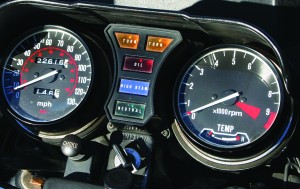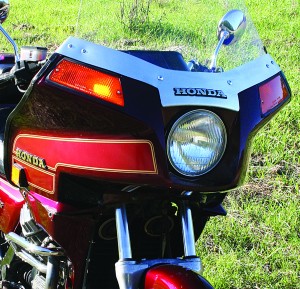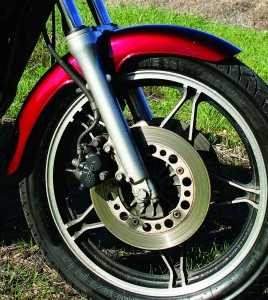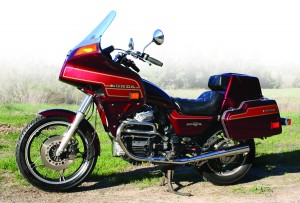Honda GL 500
| К странице. |
Мотоциклы серии GL, также как и CX разрабатывалась в середине 70-х. Первые образцы были показаны в конце десятилетия. Производство модели Honda GL 500 затягивалось, а на конвейере она простояла всего 6 лет. Внешность GL и CX перекликались практически во всем, только последняя серия была более продвинута в спортивном плане.
Чего только стоит версия CX500E с гидропневматической вилкой. Передняя вилка Showa располагает перьями размером 39 мм, «пневмоподкачкой», «антиклевком» и революционными на то время моноамортизаторами Pro-Link. Обувался байк в элитные колеса COMSTAR 18 радиуса, которые назывались в простонароде «бумеранги».
Тормозная система не отстала от подвески, впереди и сзади устанавливались только дисковые тормоза с двумя и одним поршнями соответственно. Приборная панель больше напоминает автомобильную, нежели мотоциклетную, зато она дает полную информацию, а показатели читаются безошибочно.
Недостаток приборки заключается только в отсутствии датчика показателя топлива. Для надежного пуска, силовой агрегат снабдили транзисторным зажиганием. Цепь ГРМ имеет автоматический преднатяжитель, что облегчает его эксплуатацию. Небольшой расход топлива и бак вместимостью в 19 литров, гарантирует примерно 400 км не думать о заправках.
В 70-х редко какие модели мотоциклов одевали в аэродинамический обвес и Honda CX500E не исключение. Те владельцы, которых не устраивала внешность байка, обращались к немецкому тюнинговому ателье ТТХ за обтекателями и ветрозащитой. Для спорттача, развивающего почти 200 км/час этот момент очень важен.
Немного отличается по технической начинке Honda GL 500 Silver Wing Interstate, имеющая ту же вилку и моноамортизаторы Pro-Link. Только в угоду комфорта, модель снабдили гидропневматикой 37 мм, нет также «антиклевка».
Сидеть на «пятисотом» комфортно и очень удобно. На передней панели присутствуют почти все необходимые показатели – тахометр, спидометр, одометр, лампочки указатели габаритов, включения нейтральной скорости, поворотов и дальнего света.
Технические характеристики мотоцикла Honda GL 500 1981 года выпуска:
Принадлежность к классу: дорожник;
Двигатель: 2-цилиндровый, V-образный, 4-тактный;
Охлаждение: жидкостное;
Рабочий объем, куб. см: 496;
Максимальный крутящий момент, Н•м: 46;
Мощность двигателя, л.с: 50;
Трансмиссия: 5-ступенчатая;
Тип передачи: карданная;
Максимальная скорость, км/час: 175;
Вилка: телескопическая, пневматическая;
Объём топливного бака, л: 17,5.
Мотоцикл GL500 Silverwing Interstate (1981): технические характеристики, фото, видео




new collection 1
| Основная информация | |
|---|---|
| Модель: | Honda GL 500 Silver Wing |
| Год: | 1982 |
| Тип: | Туризм |
| Двигатель и привод | |
| Рабочий объем: | 497 см 3 |
| Тип: | V2 |
| Тактов: | 4 |
| Мощность: | 50.00 л.с. (36.5 кВт)) @ 9000 об./мин. |
| Компрессия: | 10.0:1 |
| Диаметр х Ход поршня: | 78.0 x 52.0 мм (3.1 x 2.0 дюймов) |
| Клапанов: | 4 |
| Диаметр х Ход поршня: | 78.0 x 52.0 мм (3.1 x 2.0 дюймов) |
| Контроль топлива: | OHV |
| Охлаждение: | Жидкостное |
| Коробка передач: | 5 скорости |
| Привод: | Кардан (cardan) |
| Скорость и ускорение | |
| Макс. скорость: | 153.0 (95.1 mph) |
| Прочее | |
| Вместимость бензобака: | 20 л. |
| Передняя покрышка: | 3.50-19 |
| Задняя покрышка: | 130/90-16 |
| Передний тормоз: | Двойной диск |
| Задний тормоз: | Барабанный |
Извините, но данный раздел находится в разработке, пожалуйста, зайдите чуть позже
Извините, но данный раздел находится в разработке, пожалуйста, зайдите чуть позже
Извините, но данный раздел находится в разработке, пожалуйста, зайдите чуть позже
Извините, но данный раздел находится в разработке, пожалуйста, зайдите чуть позже
Извините, но данный раздел находится в разработке, пожалуйста, зайдите чуть позже
Обзор мотоцикла Honda CX500
Краткое описание и конкуренты Honda CX500
Модель дорожного мотоцикла Honda CX500 появилась в 1977 году и продавалась до 1986 года. Мотоцикл был доступен как на рынке Японии (CX400 и GL500 Custom), так и во многих других странах, включая Европу и Австралию. Модель Honda CX500 стала первым серийным мотоциклом с бескамерными шинами и турбиной (версия Honda CX500 Turbo).
Главной особенностью Honda CX500 является 2-цилиндровый V-образный двигатель жидкостного охлаждения, располагаемый в раме продольно (как на моделях V2 Moto Guzzi ), объемом 497 куб. см., выдающий 50 л.с. мощности и 46 Нм крутящего момента. Существовали также «задушенные» версии на 27 л.с. и З5 Нм, доступные на рынке Европе, и в частности, Германии. Примечательным является также тот факт, что поначалу продольно расположенный V-образный (90°) двигатель при тестировании пилотами оказался крайне неудобным эргономически (ноги упирались в карбюраторы) — для решения этой проблемы инженерам пришлось уменьшить развал цилиндров до 80°, а головки блока повернуть на 22° относительно оси цилиндра.
Из других особенностей модели Honda CX500 следует выделить стальную раму, 4-клапанные ГБЦ, дисковые тормоза, вентилятор охлаждения (работает от распредвала) и карданный привод на заднее колесо.
Основные модификации Honda CX500:
- Honda CX500E (EuroSport) — стандартная версия.
- Honda CX500C (Custom) — версия с чопперским рулем, сиденьем и одним тормозным диском спереди.
- Honda CX500 Turbo — спортивная версия с турбокомпрессором, пластиковым обтекателем и инжекторной системой питания. Выдает 82 л.с. мощности и 79 Нм крутящего момента.
- Honda GL500 Silverwing — туринговая версия с полным обтекателем, кофрами и инжекторной системой питания.
Инжектор моделей Honda CX500 Turbo и GL500 Silverwing ставился также на юбилейную версию Honda GL1200 Gold Wing .
Модель Honda CX500 продавалась до 1986 года, после чего была снята с производства. Несмотря на относительную редкость модели в России, в Европе существует множество клубов любителей и почитателей этого мотоцикла. Некоторые сообщества даже наладили производство устаревших запчастей на Honda CX500 .
Honda CX500 участвовала также в кругосветном путешествии, с 1983 по 2001 гг., проехав в общей сложности 119 стран. Примечательным является тот факт, что за все 18 лет путешествия двигатель ни разу не ремонтировался.
Retrospective: Honda GL650I Silver Wing Interstate: 1983
(This Retrospective article was printed in the February 2007 issue of Rider.)
A very sensible motorcycle, this midsize touring bike, but perhaps too sensible for the American buyer.
When you see a hundred or a thousand Gold Wingers together, more than half of them are running solo, and this Silver Wing was a perfect ride for a solo guy or gal. Less expensive and less weight, the 650 Interstate weighed a good 200 pounds less than the 1100 Interstate.
This tale began back in 1978 when Honda introduced the CX500, as useful a motorcycle as one could hope to find. The engine was an 80-degree V-twin (the Moto Guzzi was/is a 90-degree Vee), with short pushrods operating four valves per cylinder, a big bore of 78mm and short stroke of 52mm, a compression ratio of 10:1 and willing to rev to 10,000 rpm. That was impressive! The single camshaft was set high in the block, requiring a Hy-Vo chain with manual tensioning adjustment—the need for which was very infrequent. Valve adjustment was by locknut and screw, with which all the old Brit-bike enthusiasts were quite familiar. Ignition was transistorized and pointless, so to speak. Carburetion was by a pair of big 35mm constant-velocity Keihins. Liquid kept the engine cool rather than air, and the CX500 could sit in traffic on a 100-degree day and not break into a sweat. The power ran through a five-speed transmission to a shaft final drive, very neat and troublefree.
 1983 Honda GL650I Silver Wing Interstate.
1983 Honda GL650I Silver Wing Interstate.
Its frame was the backbone type, using the engine as a stressed member, with a 33mm telescopic fork at the front, a pair of shock absorbers at the back. The ComStar wheels ran tubeless tires, with a drum brake at the back, a disc on the front. The distance between the axles was a leisurely 57 inches. With 4.5 gallons in the tank, the CX tipped the scale at a reasonable 480 pounds.
Reliable horsepower ratings for that time in history are hard to come by, but the CX had in the neighborhood of 40 rear-wheel ponies at 9,000 rpm. Not that many owners were interested in having the engine spin that fast, as it was a bit of a shaker after 7,000 rpm—right where the torque maxed out at 24 lb-ft. This bike turned a respectable 14 seconds in the quarter mile at the drag strip, about half a second slower than the 13.5-second GL1000.
Sales of the CX in Europe were great. This was an eminently practical motorcycle for commuters, for two-wheeled delivery and messenger riders, for the mild-mannered type who liked the charm of two wheels without hassle and botheration. The tubeless tires were a good sales point.
 1983 Honda GL650I Silver Wing Interstate.
1983 Honda GL650I Silver Wing Interstate.
The model had a modest success here; nothing earthshaking like the CB750 of 1969 nor the GL1000 of 1975, but a good platform to be expanded on. Put on a slightly stepped saddle and a smaller tank and call it a Custom. Next move? The factory turned the motor sideways and built a one-off dirt tracker for Freddie Spencer, but that was never going to be a sales success. Perhaps that GL concept …worth looking into.
In 1981 the GL500 did appear as the Silver Wing, with a little 15-liter trunk that fit in place on the back seat for the go-to-work rider. Along with that was the full touring GL500I, I for Interstate like the Gold Wing Interstate, with a fairing and removable saddlebags.
The modular aspect of the luggage was clever, but it meant making a choice—you could either take your loved one or carry close to 30 liters of gear in the big trunk. The smaller commuter box was an option, but if you wanted to go traveling, you might as well go big. Mounting the trunk meant taking off the pillion seat and leaving it in the garage, which should have appealed to wives whose husbands liked to go traveling alone. Without a passenger saddle the tootsie-picking-up-possibilities were limited.
The 25-liter saddlebags could hold a change of clothes. Up front was a biggish frame-mounted fairing, reminiscent of the Vetter Windjammer, with a minimalist 1 inch of adjustment on the windscreen. One nice gadget was the knob for adjusting the headlight while on the bike.
In order to fit those bags in nice and close, as well as to improve handling, Honda decided to toss the twin shocks and go with a single, using the Pro-Link design derived from the motocrossers that provided rising-rate leverage: i.e., the bigger the bump, the stiffer the springing becomes. And the spring support could be enhanced by boosting the air pressure in the shock. Plus the diameter of the new fork legs was expanded to 35mm, and they were air adjustable. The wheelbase was extended by more than an inch.
Honda did some minor fiddles with the engine, claiming more horses, but with all the bodywork and a wet weight of 550 pounds the quarter-mile times went up to 15 seconds. Heck, anyone preferring speed to comfort could get himself a 12-second CB900F.
 1983 Honda GL650I Silver Wing Interstate.
1983 Honda GL650I Silver Wing Interstate.
Somewhere in there Honda decided it would be infinitely cool if the CX were also known as a go-fast kind of motorcycle, and bolted on a turbocharger and fuel injection to the 1982 CX500T. That set the world back on its butt, but the turbocharging craze—which cost all
four Japanese companies millions of unrecouped dollars—was not what the touring rider was interested in.
As an encore Honda figured the company could get inexpensive publicity by boring (82.5mm) and stroking (63mm) the CX/GL500 to 674cc. It was not quite that simple, never was with Soichiro Honda, because he wanted to be absolutely sure that everything in the engine had been strengthened (although much of that work had already been done for the turbo engine). Compression ratio and redline were both lowered a bit, and the factory was claiming 40 lb-ft of torque. The maintenance-friendly aspects of the 500 were made even more friendly on the 650, with an automatic cam-chain adjuster. Without fairing and bags, the Silver Wing could turn 13 seconds in the quarter mile.
 1983 Honda GL650I Silver Wing Interstate.
1983 Honda GL650I Silver Wing Interstate.
But did it sell? No. The whole motorcycle market was depressed, warehouses were filling up everywhere, and prices were being cut beyond the bone. Also, Honda was busily throwing itself body and soul into the V-4 world. The GL650I ended up as a one-year machine, and really cheap new ones could still be found two, three years later. Maybe that is why Honda has refused to bring in its latest midsize touring bike, the Deauville 650, a model that is very popular in Europe.


